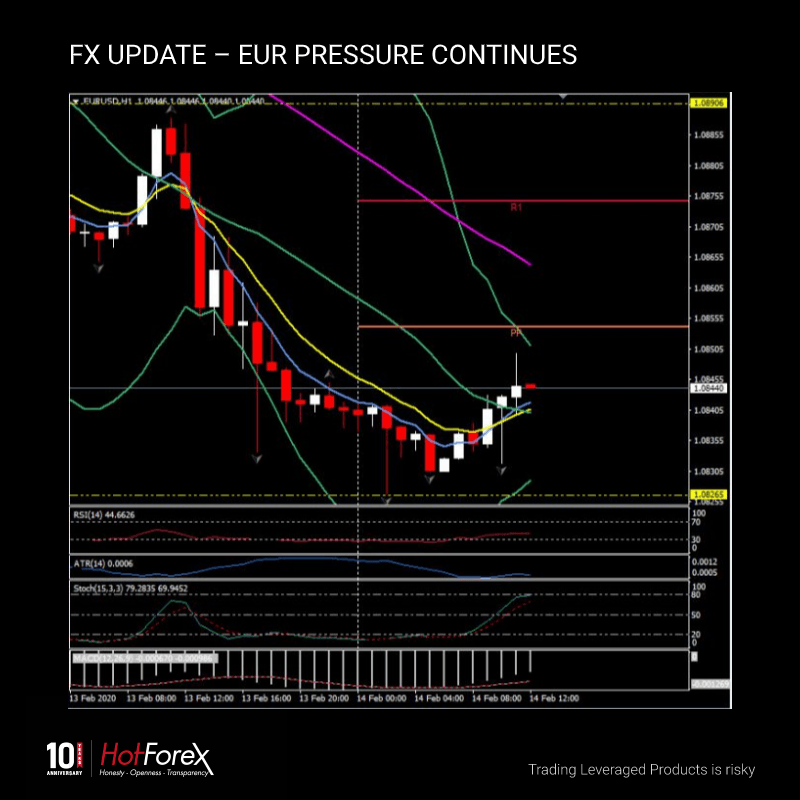EUR/USD, H1/Weekly
Germany’s economy stagnated in Q4 last year, in line with a number of forecasts and a tad below consensus expectations, which had predicted a slight expansion of 0.1% q/q. Compared to negative quarterly prints in France and Italy, Germany is already the outperformer among the three big Eurozone countries and Q3 numbers for Germany were revised up to 0.2% from 0.1% reported initially. This left the working day adjusted annual rate 0.4% y/y a tad higher than anticipated, but down from 1.1% y/y in Q3. There is no full breakdown yet, but the stats office reported that private as well as public consumption slowed in the last quarter of 2019, while investment was mixed with construction investment, expanding again. Exports contracted, while imports picked up according to first estimate. Looking ahead, exports are likely to continue to suffer and orders numbers are predicting another weak quarter for manufacturing, which leaves the risk that the labour market will start to suffer. The balance of risks clearly is tilted to the downside not just for Germany’s economy.
The Euro posted fresh lows against the Dollar and other currencies, while both the safe haven Yen and Swiss franc lost yesterday’s bid as the daily increment of new coronavirus cases in China fell back alongside narratives that are downplaying yesterday’s jump in total reported cases in Hubei province as being just a reclassification. EURUSD posted a fresh 34-month low at 1.08265, and is set for its biggest two-week loss since July 2019. Today, the German GDP helped lift it to 1.0840 with the broader GDP data for the wider Eurozone yet to come. EURJPY printed a four-month low, at 118.86, and EURCHF a near-five-year-low, at 1.0609. EURGBP yesterday saw a two-month low below at 0.8295.
Elsewhere, USDJPY settled in the upper 109.00s, above the four-day low seen yesterday at 109.61. Cable consolidated gains seen yesterday, holding just shy of the nine-day high at 1.3069.
The EURUSD low earlier tested the S2 and 161.8 Fibonacci extension low of the December rally at 1.0820, below there is the daily lower channel at 1.0750. In the the longer term the 161.8 Fibonacci extension level from the Q419 rally is at 1.0650 and then the psychological 1.0500. The Q419, against the trend, re-trace rally came from this over extension from the 200-day moving average which is where we are now, so some retrace to possibly the 1.1050-75 zone could be expected.
Disclaimer: Nothing in this communication contains, or should be considered as containing, an investment advice or an investment recommendation or a solicitation for the purpose of purchase or sale of any financial instrument.
Recommended Content
Editors’ Picks
AUD/USD jumps above 0.6500 after hot Australian CPI data

AUD/USD extended gains and recaptured 0.6500 in Asian trading, following the release of hotter-than-expected Australian inflation data. The Australian CPI rose 1% in QoQ in Q1 against 0.8% forecast, providing extra legs to the Australian Dollar upside.
USD/JPY hangs near 34-year high at 154.88 as intervention risks loom

USD/JPY is sitting at a multi-decade high of 154.88 reached on Tuesday. Traders refrain from placing fresh bets on the pair as Japan's FX intervention risks loom. Broad US Dollar weakness also caps the upside in the major. US Durable Goods data are next on tap.
Gold price cautious despite weaker US Dollar and falling US yields

Gold retreats modestly after failing to sustain gains despite fall in US Treasury yields, weaker US Dollar. XAU/USD struggles to capitalize following release of weaker-than-expected S&P Global PMIs, fueling speculation about potential Fed rate cuts.
Crypto community reacts as BRICS considers launching stablecoin for international trade settlement

BRICS is intensifying efforts to reduce its reliance on the US dollar after plans for its stablecoin effort surfaced online on Tuesday. Most people expect the stablecoin to be backed by gold, considering BRICS nations have been accumulating large holdings of the commodity.
US versus the Eurozone: Inflation divergence causes monetary desynchronization

Historically there is a very close correlation between changes in US Treasury yields and German Bund yields. This is relevant at the current juncture, considering that the recent hawkish twist in the tone of the Fed might continue to push US long-term interest rates higher and put upward pressure on bond yields in the Eurozone.

